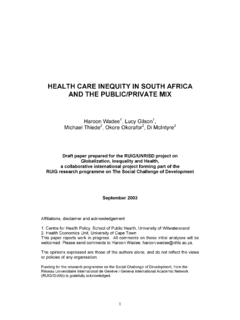Transcription of A POLICY ON QUALITY IN HEALTH CARE FOR SOUTH …
1 A POLICY ON QUALITY IN HEALTH care FOR SOUTH africa National Department of HEALTH , Pretoria April 2007 Abbreviated version )RUHZRUGThis abbreviated version of the POLICY on QUALITY in HEALTH care for SOUTH africa follows on the original that became national POLICY in 2001. It comes at a time when the public HEALTH care system is in dire need of again refocusing its collective efforts towards improving the QUALITY of care provided in public HEALTH facilities and communities. Knowing that QUALITY is never an accident, always the result of high intention, sincere effort, intelligent direction and skilfull execution, and that it represents the wise choice of many alternatives, this abbreviated version attempts to provide to all public HEALTH officials in a nutshell and in a more reader friendly language, the strategic direction HEALTH facilities and officials need to follow to assure QUALITY in HEALTH care and continuous improvement in the care that is being provided.
2 HEALTH care personnel are encouraged to use this copy of the POLICY to focus their intentions and guide their T D MSELEKU DIRECTOR-GENERAL: HEALTH 1 ContentsA. Background to the POLICY 2 1. A QUALITY assurance POLICY for the whole HEALTH system - public and private 2 2. The key aims of the POLICY 2 3. The problems with QUALITY in HEALTH care 3 4. Issues addressed in developing the POLICY Improve access to QUALITY HEALTH care 3 Increase patients' participation and the dignity afforded to them 4 Reduce underlying causes of illness, injury, and disability 5 Expand research on treatments specific to SOUTH African needs and on evidence of effectiveness 5 Ensure appropriate use of services 5 Reduce errors in HEALTH care 6 5.
3 Targeting QUALITY assurance interventions 6 Interventions aimed at HEALTH professionals 6 Interventions aimed at patients 7 Interventions aimed at the community 7 Interventions aimed at systems 8 B. The POLICY 1. Creating the environment in which QUALITY HEALTH care will flourish 9 Strengthening the hand of the user 9 Focusing on equity of HEALTH care and vulnerable populations 10 Promoting public/private partnerships and the accountability of both sectors for QUALITY improvement 10 Reducing errors and increasing safety in HEALTH care 12 2.
4 Building the capacity to improve QUALITY 12 Fostering evidence-based practice and innovation 13 Adapting organisations for change 14 Engaging the HEALTH care workforce 14 Training and professional development 15 Investing in information systems that measure QUALITY improvements 16 3. Delivering QUALITY care - in the public sector 17 The District HEALTH system 17 The District HEALTH team 17 Provincial Departments of HEALTH 19 Monitoring standards 19 QUALITY monitoring by the user of services 19 QUALITY monitoring through structures of governance 20 QUALITY monitoring by the provider of services 21 QUALITY monitoring by
5 Professional bodies 222A. Background to the POLICY 1. A QUALITY assurance POLICY for the whole HEALTH system - public and private Each year 8% or more of the gross national product (GNP is an indicator of the wealth produced by the country) is spent on the national HEALTH system, including both the public and private HEALTH sectors. On average 60% of this is spent in the private sector, which provides care to 20% of the population. 80% of the population relies on the public HEALTH system for HEALTH care . This sector receives 40% of total expenditure on HEALTH . Any national POLICY must therefore include both private and public sector issues, and by so doing contribute towards strengthening the partnership between the public and private sector. 2. The key aims of the POLICY The National POLICY on QUALITY in HEALTH care provides a way to improve the QUALITY of care in both the public and private sectors.
6 The POLICY sets out the main objectives of Government to assure QUALITY in HEALTH care and to continuously improve the care that is being provided. Achieving the goal of a QUALITY HEALTH care system requires a national commitment to measure, improve and maintain high- QUALITY HEALTH care for all its citizens. This involves measuring the gap between standards and actual practice, and working out ways to close the gap. The national aims also reflect the needs of specific vulnerable populations and geographical areas. Within each of these broad aims, HEALTH care providers should establish specific measurable objectives so that they can track progress in achieving these aims. National aims for improvement include, but are not limited to: Addressing access to HEALTH care ; Increasing patients' participation and the dignity afforded to them; Reducing underlying causes of illness, injury, and disability through preventive and HEALTH promotion activities; Expanding research on evidence of effectiveness; Ensuring the appropriate use of HEALTH care services; and Reducing HEALTH care errors (adverse events).
7 3 Priority is given in the POLICY to:x Conditions where most improvement can occur, and which have the greatest impact on reducing the burden of disease, mortality and improving patients' QUALITY of life and their ability to function; x Conditions where there is wide variation in service, indicating that many HEALTH care practices may be inappropriate and not in line with current knowledge about effective HEALTH care ; and x Conditions that is common and/or costly, where improvements will most broadly result in better HEALTH of the population and more appropriate use of HEALTH The problems with QUALITY in HEALTH care Many QUALITY problems in HEALTH care have been identified, in both the public and the private sectors. These include: x Under-use and overuse of services;x Avoidable errors; x Variation in services; x Lack of resources;x Inadequate diagnosis and treatment; x 3 UREOHPV UHODWLQJ WR WKH UHDOORFDWLRQ RI IXQGV IURP EHWWHU RII WR KLVWRULFDOO\ SRRUHU FRPPXQLWLHV DQG IDFLOLWLHV x Inefficient use of resources; x Poor information; x An inadequate referral system; x Disregard for human dignity; x Drug shortages;x Records not well kept; and x Poor delivery shortcomings endanger the HEALTH and lives of all patients, add costs to the HEALTH care system, and reduce productivity.
8 To achieve necessary improvements, a national POLICY on QUALITY in HEALTH care is needed, together with commitment from all stakeholders, beginning with leadership from the highest levels of government, the national HEALTH system, labour, and the HEALTH care professions. 4. Issues addressed in developing the POLICY Improve access to QUALITY HEALTH care Reduce excess capacity, plan packages of care at each level of care andallocate resources equitably to improve access to appropriate HEALTH care . 4 HEALTH care capacity should be matched to the HEALTH needs of the population - There is a need to reduce excess capacity, avoid waste and reduce costs, as well as increase capacity in other areas to ensure access for under-served populations, and ensure that the care provided across the HEALTH care system is appropriate. Improved co-ordination of capacity - Access to knowledgeable and experienced HEALTH professionals is essential to improve access to QUALITY HEALTH care .
9 Also, research shows that facilities and practitioners that perform a higher volume of specific procedures can achieve better results than those that perform relatively few of the same procedures. Improved planning for which services are to be provided at which levels can help to maximize the benefits of volume and expertise. An increase in HEALTH care capacity increases HEALTH care use - With more services and resources available, more people will want to use these services. This can help to extend the delivery of HEALTH care services to previously under-served populations. Inadequate HEALTH care capacity, particularly in rural areas - In these areas, there needs to be targeted development efforts and new methods of delivering QUALITY HEALTH care . For example, good QUALITY care cannot be provided without high- QUALITY doctors, but in many remote rural areas there are too few doctors. One approach is to limit new private medical practices in areas where there is already an oversupply of GRFWRUV XVLQJ WKH FHUWLILFDWHV RI QHHG SUocedure contained in the National HEALTH Act, Act 61 of 2003.
10 Increase patients' participation and the dignity afforded to them Informing patients and involving them in decision-making - The active participation of patients in their care can improve the effectiveness of care as well as their satisfaction with their care . Patients who are treated with dignity and are well informed and able to participate in treatment decisions are more likely to comply with their treatment plans. Enabling patients to care for themselves - Empowering individuals with the skills and tools to care for themselves is especially important for individuals with chronic illness or disability. Enabling users to assess their HEALTH , practise preventive HEALTH care , and self- care , will improve their HEALTH and reduce unnecessary HEALTH care services and costs. Community participation - Not only individuals need to be encouraged to participate in HEALTH care , but also whole communities.







